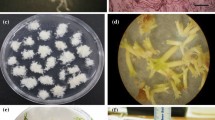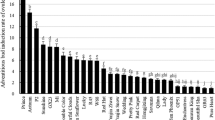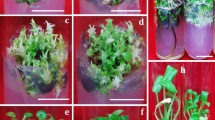Abstract
We report the regeneration of flowering plants in rose (Rosa hybrida L.) via somatic embryos continuously produced from long–term cultures of friable embryogenic tissue. Filament explants from young flower buds were cultured on a medium based on B5 modified salts giving rise to a semi–hard type callus. Globular embryos differentiated from this primary callus in the presence of 2,4–D and zeatin after subculture. These embryos are an excellent source of friable embryogenic tissue, in the presence of α–napthaleneacetic acid (NAA) and zeatin, that maintains its regeneration capacity for more than 18 months through periodic subculture in a high 2,4–D/zeatin medium. Somatic embryos were periodically isolated from embryogenic tissue and have undergone differentiation, maturation, germination and plantlet development. Plantlets obtained through this method developed normally in the greenhouse, similar to the micropropagated controls. Upon flowering, these plants proved to be morphologically true to type and displayed the flower color of the donor genotype.
This is a preview of subscription content, access via your institution
Access options
Subscribe to this journal
Receive 12 print issues and online access
$209.00 per year
only $17.42 per issue
Buy this article
- Purchase on Springer Link
- Instant access to full article PDF
Prices may be subject to local taxes which are calculated during checkout
Similar content being viewed by others
References
Wit, J.C., Esendam, H.F., Honkanen, J.J. and Tuominen, U. 1990. Somatic embryogenesis and regeneration of flowering plants in rose. Plant Cell Reports. 9: 456–458.
Burger, D.W., Liu, L., Tary, K.W. and Lee, C.I. 1990. Organogenesis and plant regeneration from immature embryo of Rosa hybrida L. Plant Cell, Tissue and Organ Culture. 21: 147–152.
Ishioka, N. and Tanimoto, S. 1990. Plant regeneration from Bulgarian rose callus. Plant Cell, Tissue and Organ Culture. 22: 197–199.
Lloyd, D., Roberts, A.V. and Short, K.C. 1988. The induction in vitro of adventitious shoots in Rosa. Euphytica 37: 31–36.
Hasegawa, P.M. 1979. In vitro propagation of rose. Hort. Sci. 14: 610–612.
Skirvin, R.M. and Chu, M.C. 1979. In vitro propagation of ‘Forever Yours’ rose. Hort. Sci. 14: 608–610.
Khosh-Khui, M. and Sink, K.C. Micropropagation of new and old world rose species. J. Hortic. Sci. 57(3):315–319.
Nash, D.T. and Davies, M.T. 1972. Some aspects of growth and metabolism of Paul's scarlet rose cell suspension. J. Exp. Bot. 23: 75–91.
Tabaeezadeh, Z. and Khosh-Khui, M. 1981. Anther culture of Rosa. Scientia Hort. 15: 61–66.
Strauss, A. and Potrykus, E. 1980. Callus formation from protoplasts of cell suspension cultures of rosa Paul Scarlet. Physiol. Plant. 48: 15–20.
Söndahl, M.R., Salisbury, J.L. and Sharp, W.R. 1979. SEM characterization of embryogenic tissue and globular embryos during high frequency somatic embryogenesis in coffee callus cells. Z. Planzenphysiol 94: 185–188.
Street, H.E. 1979. Embryogenesis and chemically induced organo-genesis. In: Plant Cell and Tissue Culture. Principles and Applications. W. R. Sharp, P. O. Larsen, E. F. Padock, and V. Raghavan (Eds.). Ohio State University Press, Columbus, OH.
Green, C.E. 1982. Somatic embryogenesis of Zea mays, p. 107–108. In: Plant Tissue Culture. Proc. Fifth Internal Congress on Plant Tissue and Cell Culture. A Fujiwara (Ed.). Maruzen Publ., Tokyo.
Prioli, L.M. and Söndahl, M.R., 1989. Plant Regeneration and recovery of fertile plants from protoplasts of maize (Zea mays L). Bio/Technology 7: 589–594.
Ammirato, P.V. 1974. The effects of abscisic acid on the development of somatic embryos from cells of caraway (Carum carvi L). Bot. Gaz. 135: 328–337.
Roberts, D.R., Flinn, B.S., Webb, D.T., Webster, F.B. and Sutton, B.C.S. 1990. Abscisic acid and indole-3-butyric acid regulation of maturation and accumulation of storage proteins in somatic embryos of interior spruce. Physiol. Plant. 78: 355–360.
Gamborg, O.L., Miller, R.A. and Ojuna, K. 1968. Nutrient requirements of suspension cultures of soybean root cells. Exp. Cell Res. 50: 151–158.
Kao, K.N. and Michayluk, M.R. 1975. Nutritional requirements for growth of Vicia hajastana cells and protoplasts at very low population density in liquid media. Planta 126: 105–110.
Murashige, T. and Skoog, F. 1962. A revised medium for rapid growth and bioassays with tobacco tissue cultures. Physiol. Plant. 15: 473–497.
Chu, C.C., Wang, C.C., Sun, C.S., Hsu, C., Yin, K.C., Chu, C.Y. and Bi, F.Y. 1975. Establishment of an efficient medium for anther culture of rice through comparative experiments on the nitrogen sources. Scientia Sinica 18: 659–668.
Author information
Authors and Affiliations
Rights and permissions
About this article
Cite this article
Noriega, C., Söndahl, M. Somatic Embryogenesis in Hybrid Tea Roses. Nat Biotechnol 9, 991–993 (1991). https://doi.org/10.1038/nbt1091-991
Received:
Accepted:
Issue Date:
DOI: https://doi.org/10.1038/nbt1091-991
This article is cited by
-
Genetic analysis of callus formation in a diversity panel of 96 rose genotypes
Plant Cell, Tissue and Organ Culture (PCTOC) (2020)
-
The Influence of Plant Growth Regulators and Light Quality on Somatic Embryogenesis in China Rose (Rosa chinensis Jacq.)
Journal of Plant Growth Regulation (2014)
-
Efficiency of direct and indirect shoot organogenesis in different genotypes of Rosa hybrida
Plant Cell, Tissue and Organ Culture (PCTOC) (2013)
-
A rapid system for micropropagation of Swertia chirata Buch-Ham. ex Wall.: an endangered medicinal herb via direct somatic embryogenesis
Acta Physiologiae Plantarum (2011)
-
Somatic embryogenesis and plant regeneration in zygotic embryo explant cultures of rugosa rose
Plant Biotechnology Reports (2009)



